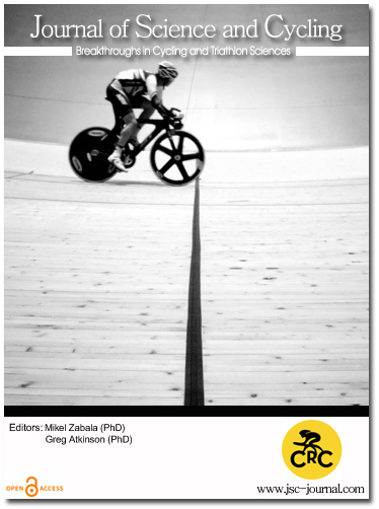Rehabilitation of a tibial plateau fracture within an elite female mountainbiker. A case report
Abstract
Tibial plateau fractures present a challenging problem for elite athletes and medical personnel, with many athletes failing to return to previous sporting levels post fracture (Johansson etal, 1992). An elite professional female endurance mountainbiker (Age: 32, Height: 1.58m, Body Mass: 51kg) presented 3 weeks post injury with a severe left tibial plateau fracture, caused by a fall when skiing. An orthopaedic surgeon in France inserted two screw fixations from lateral to medial condyles within the left tibia. X-rays and CT scans revealed a large degree of damage to the superolateral surface of the tibial plateau. The surgeon described an unusual and potentially career threatening injury. The athlete was advised to completely rest for a minimum of 10 weeks. This created uncertainty and concern for future career status and sponsorship. Prior to injury, a 12 week training period in France involved intensive skiing and running on steep alpine roads. During this time the athlete experienced progressive knee pain, perhaps caused by a change in knee load relative to high volume cycling. According to Bargfeldt etal (2011) high impact training loads may cause microcracks within the tibia. Furthermore, female athletes are at particular risk due to amenorrhea, a reduction in oestrogen levels and resultant reduction in bone mass.
During initial consultation the athlete had expressed a desire to compete in a UCI mountain bike race 17 weeks post injury. As a result, a 14 week progressive rehabilitation programme was administered. Initially, a cryocuff was applied to limit knee effusion, crutch walking was amended to ensure a correct gait pattern was maintained. To limit physical conditioning non weight bearing pool running with floatation harness was introduced at week 4. Bike Positioning (45° spinal flexion, 35° knee flexion) was replicated during pool running to simulate mountain bike position (Bini etal, 2011). Underwater cameras allowed continual visual feedback. High intensity (threshold and suprathreshold) efforts against pool flume resistance matched intended high intensity bike training. At the end of each pool session badu massage jets were self-administered to assist in the recovery process. Further endurance pool running was directed utilising a public swimming pool. This enabled the athlete to maintain intended cycling training volume and conditioning. Additional physiological effects of pool hydrostatic pressure assisted increased circulation due to the compressive effects on soft tissue (Thein & Brody 1998). Progressive modified mountain bike specific strength and conditioning, and flexibility home exercises were also introduced.
From weeks 4-8, weekly examination and assessment determined progression and modification of prescribed exercises. Crutch walking progressed from non-weight bearing, partial weight bearing with two crutches, to single crutch walking. Progression to underwater treadmill gait, initially at 10% body weight with flume jet resistance was applied to progressively develop confidence and monitor impact. Underwater forward/backward/side step and hop using a step box also instilled confidence in safe progression to land based functional exercises. At week 10 examination and assessment revealed symmetry in lower limb muscle bulk. Static endurance cycling on an indoor wind trainer replaced the pool endurance sessions. Proprioception exercises progressed from pool to land. After discussion, the patient expressed self-doubt and reluctance at the prospect of progressing to cycling outdoors. It was apparent there was a dependence on advice and prescription, rather than a return to independent training. However, after consultation a return to mountain biking on roads and tracks commenced. At week 12 the Functional Movement Screen (FMS) was selected as a valid objective measurement tool to establish kinetic chain discrepancies (Minick etal, 2010). Initial tests revealed low scoring levels of 1 for deep squat, hurdle step, inline lunge, trunk stability pushup and rotary stability. Consequently, home strength and conditioning and flexibility exercises were modified to address asymmetry. A UK based orthopaedic surgeon confirmed full union was established at week 16, with no perceived problems returning to mountain bike competition. Biodex dynamometer and Biodex balance system (Biodex Medical, New York, USA) baseline measures were also applied with data used to guide amendments in training. The FMS was retested and compared to week 12. Results revealed improvements for deep squat, hurdle step, inline lunge, trunk stability pushup and rotary stability. However, conditioning would continue due to the overall score remaining at 13/21. The athlete continued to improve on the bike with hill climbs and time trials used as sports specific baseline measures. This enabled a confident safe return to compete at the week 17 target UCI international mountainbike race. The race was completed with no aggravation of the affected knee. Considering the rehabilitation of a complex potentially career threatening injury, which occurred 17 weeks previously, the athlete achieved a credible 5th place in the Elite women’s category. Subsequent results for the remainder of the season included multiple wins in elite mountainbike stage races.
Regardless of the complexity of injury, the application of an evidenced based multidisciplinary approach, employing specificity to the athletes sporting demands provides optimal rehabilitation of the elite athlete.
Downloads
Published
How to Cite
Issue
Section
Copyright (c) 2015 Journal of Science and Cycling

This work is licensed under a Creative Commons Attribution-NonCommercial 4.0 International License.
Authors contributing to Journal of Science and Cycling agree to publish their articles under a Creative Commons CC BY-NC-ND license, allowing third parties to copy and redistribute the material in any medium or format, and to remix, transform, and build upon the material, for any purpose, even commercially, under the condition that appropriate credit is given, that a link to the license is provided, and that you indicate if changes were made. You may do so in any reasonable manner, but not in any way that suggests the licensor endorses you or your use.
Authors retain copyright of their work, with first publication rights granted to Cycling Research Center.






